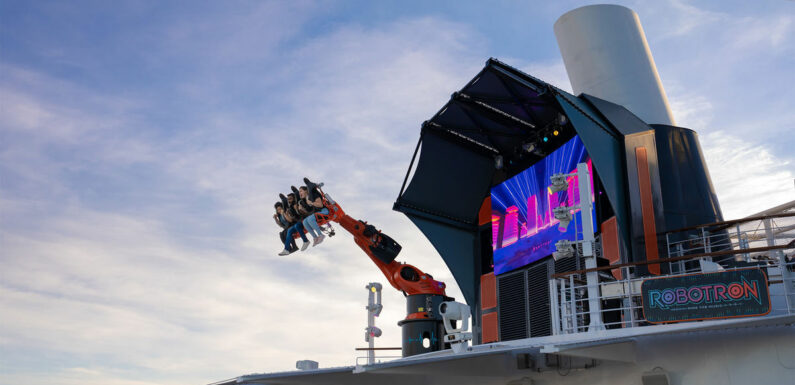
Immersive experiences that blur reality are a growing trend on cruise ships as lines look for more meaningful ways to entertain guests.
Think sipping a color-changing drink at an octopus-themed bar while watching fish swim past virtual underwater windows. Or a chef smaller than a saltshaker projected onto a table preparing appetizers.
“What audiences as a whole are looking for are things that are more meaningful,” said Mark Amos, an executive vice president of attraction design firm JRA, a subsidiary of RWS Entertainment Group, which has orchestrated immersive events on cruise lines including Azamara, Holland America Line, MSC Cruises and Virgin Voyages.
Amos described immersive experiences as fully engaging the guest with an environment, activity or ride that transports them to a different place, real or imaginary, and to varying degrees, making them feel a part of the action rather than a passive observer.
“Within that place or space, we deliver a multisensory experience that takes them on a journey to suspend belief, even if only momentarily, where they are, what they can do, who they’re with, and that they’re able to affect the outcome or be affected by the outcome,” Amos said.
JRA was responsible for evolving the Robotron ride on the MSC Seascape into a creative, immersive experience. The ride incorporates the senses, he said, such as touch, by allowing guests to push buttons to choose their music, sights and sounds as Robotron whips them around on the ship’s upper deck. Guests can also take in the sights and sounds of the ride while at a nearby bar. A takeaway photo or video clip from the Robotron lets riders relive it later.
“So when you’re down on the pool deck, talking about the near-hurling experience that you had up on this ride, you have the ability to show it, to share it and to re-experience what you had on that ride,” Amos said.
Immersive experiences can be revenue generators. For instance, the Robotron costs $10 to ride. But many are complimentary. On the line’s newest ship, the World Europa, JRA debuted “Living Exhibition: Earth.”
The exhibition begins with an artist painting a picture, the subjects of which are represented in real life by decor that inflates and by dancers and puppets who meet on the ship where the artist is painting — such as a 15-foot elephant controlled by people inside of it.
Dinner and a show
Quite a few cruise brands have chosen to incorporate immersive experiences into their dining programs. Disney Cruise Line’s newest ship, Disney Wish, offers a range of immersive experiences, including the Avengers: Quantum Encounter dinner.
Guests play an interactive role in an Avengers mission with Ant-Man and The Wasp, who use highly unstable technology to shrink and grow targets. A few blunders and the arrival of a villain require guests to use a “Quantum Core” device at their table help save the two heroes.
On Celebrity Cruises, a white table becomes the venue for a small, animated chef who cooks and tells stories during Le Petit Chef dining experience. Celebrity worked with the 3D animators of Skullmapping to create the experience, in which the chef talks to guests as he prepares dishes right at their place setting. When he’s done with a course, the chef cues waiters to replace the animated dish with the real deal as part of a four-course dinner.
Dondra Ritzenthaler, Celebrity’s longtime senior vice president of sales for the Americas, described experiences like these as “over the top” but said they are the kind of innovations guests are looking for. Le Petit Chef costs $55 with the option of a wine pairing at an additional cost.
“I have literally been in the restaurant, and when it’s over, people are waving goodbye at the table at this little animated character,” she said. “They’re telling us with their pocketbook that these are the things that they want and that they value.”
Princess Cruises blends taste with technology in “360: An Extraordinary Experience,” available exclusively and included for guests in suite accommodations on the Discovery Princess and Enchanted Princess. The event takes guests through a seven-course meal while immersing them in the views, sounds and people from the places where the ingredients are harvested. LED projections enable them to interact with the culture, like smashing a projected plate while dining in Greece, echoing the Greek custom.
Creating the atmosphere
Other experiences are atmospheric. Carnival Cruise Line is planning several immersive zones, its name for the different areas of its Excel-class ships, on the Carnival Jubilee due out in December.
The two-deck Currents zone will have LED “windows” displaying fish swimming alongside the ship and a wave-shaped LED ceiling featuring other sea creatures and scenes that change from day to night. Completing the experience is a bar with eight octopus tentacles wrapped around it serving drinks that change color in recognition of an octopus’ ability to do the same.
Cruise line entertainment has “catapulted” away from predictable experiences, said Craig Laurie, chief creative officer of RWS Entertainment Group.
“I feel like our clients are coming to us being like, how can we give them the unexpected, obviously, in a very enjoyable way?” he said. “They’re excited to take risks, to give the audience something that will inspire and excite them.”
Source: Read Full Article












